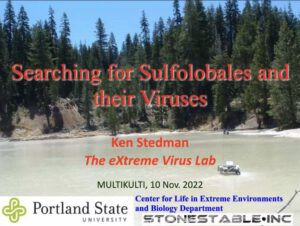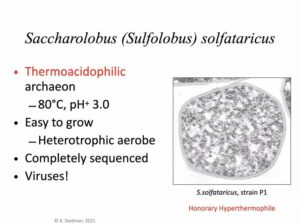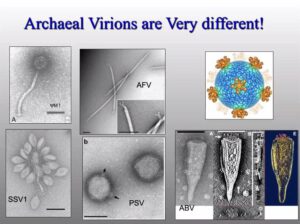As part of the MultiKulti-Webinar series, we welcomed Prof. Dr. Ken Stedman (Portland State University, USA). In his presentation “Searching for Sulfolobales and their viruses” he gave us insights into the history of isolation and cultivation of these extremophilic archaea and their “extreme” viruses.
The team led by Prof. Stedman, the “virus hunters”, is investigating microorganisms and their viruses from extreme habitats such as Boiling Springs Lake in Lassen Volcanic Natural Park, California or the “blood pond” Chinoike Jigoku in Japan. The areas studied have high temperatures of up to 95°C and extremely low pH values (~pH 2). The microorganisms that can persist under these conditions often belong to the domain Archaea and their adaptations are of great microbiological, as well as biotechnological interest.
Among these thermoacidophilic organisms is the species Saccharolobus (Sulfolobus) solfataricus, which, although not a dominant representative in the microbial community of extreme habitats, has been regularly isolated.
Thus, the first isolates from the crater “Pisciarelli Solfatara” near Naples (Italy) were described as “Caldariella sp.” (De Rosa et al., 1975). Already this paper indicates that the cells should be “enriched as soon as possible” and not be stored at in situ temperature, but cooler, until cultivation, otherwise they will quickly lose their viability. Later, Zillig et al. (1980) isolated their own strains of the Sulfolobus-“Caldariella” group from Pisciarelli Solfatara, and cultures from samples transported at 15°C, instead of optimum temperature, grew best, confirming the result of De Rosa et al. (1975).
Furthermore, Prof. Stedmen reported from his experience that the lower solubility of oxygen at high temperatures need to be considered and that it is advisable to store the samples in anaerobic tubes until cultivation. In addition, for cultivation at 80°C he is using flasks with a long neck on which evaporated medium condenses and flows back.
After the impressive anecdotes about sampling at extreme locations and tips for cultivation, Prof. Stedman explained in his talk how he and his group succeeded in isolating viruses from these extremophilic archaea. Those methods are summarized in his article The isolation of viruses infecting Archaea (Stedman et al., 2010). The found viruses exhibit a great diversity, showing different morphologies in electron micrographs – from long and filamentous to shapes looking like bottles or lemons. The talk concluded with remarks on the analysis of viral metagenomes, which may answer exciting new questions in the future.
An interesting presentation, which fascinated not only the microbiologists in the team and among the guests. We sincerely thank Prof. Ken Stedman for his interesting lecture across time zones.
The next MultiKulti webinar will take place on January 12, 2023 at 4:15 p.m.



